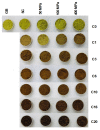Enzymatic Activity and Its Relationships with the Total Phenolic Content and Color Change in the High Hydrostatic Pressure-Assisted Curing of Vanilla Bean (Vanilla planifolia)
- PMID: 38005328
- PMCID: PMC10674283
- DOI: 10.3390/molecules28227606
Enzymatic Activity and Its Relationships with the Total Phenolic Content and Color Change in the High Hydrostatic Pressure-Assisted Curing of Vanilla Bean (Vanilla planifolia)
Abstract
Diverse enzymatic reactions taking place after the killing of green vanilla beans are involved in the flavor and color development of the cured beans. The effects of high hydrostatic pressure (HHP) at 50-400 MPa/5 min and blanching as vanilla killing methods were evaluated on the total phenolic content (TPC), polyphenoloxidase (PPO), and peroxidase (POD) activity and the color change at different curing cycles of sweating-drying (C0-C20) of vanilla beans. The rate constants describing the above parameters during the curing cycles were also obtained. The TPC increased from C1 to C6 compared with the untreated green beans after which it started to decrease. The 400 MPa samples showed the highest rate of phenolic increase. Immediately after the killing (C0), the highest increase in PPO activity was observed at 50 MPa (46%), whereas for POD it was at 400 MPa (25%). Both enzymes showed the maximum activity at C1, after which the activity started to decrease. As expected, the L* color parameter decreased during the entire curing for all treatments. An inverse relationship between the rate of TPC decrease and enzymatic activity loss was found, but the relationship with L* was unclear. HHP appears to be an alternative vanilla killing method; nevertheless, more studies are needed to establish its clear advantages over blanching.
Keywords: color; high hydrostatic pressure (HHP); peroxidase (POD); polyphenol oxidase (PPO); total phenolics (TPC); vanilla curing.
Conflict of interest statement
The authors declare no conflict of interest.
Figures




Similar articles
-
Microstructural Changes in Vanilla planifolia Beans after Using High-Hydrostatic-Pressure Treatment in the Curing Process.Foods. 2024 Jan 5;13(2):177. doi: 10.3390/foods13020177. Foods. 2024. PMID: 38254478 Free PMC article.
-
Metabolite transformation and β-d-glucosidase activity during the high hydrostatic pressure assisted curing of vanilla beans (Vanilla planifolia) to improve phenolic compounds formation.Food Chem. 2022 Aug 1;384:132497. doi: 10.1016/j.foodchem.2022.132497. Epub 2022 Feb 17. Food Chem. 2022. PMID: 35219994
-
Effects of high hydrostatic pressure on enzymes, phenolic compounds, anthocyanins, polymeric color and color of strawberry pulps.J Sci Food Agric. 2011 Mar 30;91(5):877-85. doi: 10.1002/jsfa.4260. Epub 2011 Jan 6. J Sci Food Agric. 2011. PMID: 21384355
-
Vanilla--its science of cultivation, curing, chemistry, and nutraceutical properties.Crit Rev Food Sci Nutr. 2013;53(12):1250-76. doi: 10.1080/10408398.2011.563879. Crit Rev Food Sci Nutr. 2013. PMID: 24090143 Review.
-
High Hydrostatic Pressure to Increase the Biosynthesis and Extraction of Phenolic Compounds in Food: A Review.Molecules. 2022 Feb 23;27(5):1502. doi: 10.3390/molecules27051502. Molecules. 2022. PMID: 35268602 Free PMC article. Review.
Cited by
-
Microstructural Changes in Vanilla planifolia Beans after Using High-Hydrostatic-Pressure Treatment in the Curing Process.Foods. 2024 Jan 5;13(2):177. doi: 10.3390/foods13020177. Foods. 2024. PMID: 38254478 Free PMC article.
-
Influence of Traditional Vanilla Curing on Its Physicochemical Properties and Aromatic Profile.Foods. 2025 May 7;14(9):1652. doi: 10.3390/foods14091652. Foods. 2025. PMID: 40361735 Free PMC article.
References
-
- Peña-Barrientos A., de Jesús Perea-Flores M., Martínez-Gutiérrez H., Patrón-Soberano A., González-Jiménez F.E., Vega-Cuellar M.Á., Davila-Ortiz G. Physicochemical, microbiological, and structural relationship of vanilla beans (Vanilla planifolia, Andrews) during traditional curing process and use of its waste. J. Appl. Res. Med. Plants. 2022;32:100445. doi: 10.1016/j.jarmap.2022.100445. - DOI
-
- Odoux E., Escoute J., Verdeil J.L. The relation between glucovanillin, β-D-glucosidase activity and cellular compartmentation during the senescence, freezing and traditional curing of vanilla beans. Ann. Appl. Biol. 2006;149:43–52. doi: 10.1111/j.1744-7348.2006.00071.x. - DOI
-
- Márquez O., Waliszewski K.N. The effect of thermal treatment on β-glucosidase inactivation in vanilla bean (Vanilla planifolia Andrews) Int. J. Food Sci. 2008;43:1993–1999. doi: 10.1111/j.1365-2621.2008.01804.x. - DOI
-
- Buitimea-Cantúa G.V., Welti-Chanes J., Escobedo-Avellaneda Z.J. Metabolite transformation and ß-D-glucosidase activity during the high hydrostatic pressure assisted curing process of vanilla beans (Vanilla planifolia) to improve phenolic compounds formation. Food Chem. 2022;384:132497. doi: 10.1016/j.foodchem.2022.132497. - DOI - PubMed
MeSH terms
Substances
LinkOut - more resources
Full Text Sources
Research Materials

